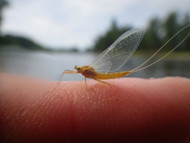Tips and Strategies for a PMD Hatch
If you have ever tried dry fly fishing during a hatch, you already know that it can be equally exciting and frustrating at the same time. Understanding PMD mayfly behavior patterns will help you become more successful next time!
They are abundant, widespread in all types of rivers from small spring creeks to big tailwater rivers, emerge slowly enticing trout to feed on them, and their hatches are fairly consistent for three to six weeks, which means if you miss them one day you should find them still hatching the next.
Where and when
The hatch of course varies, but start looking for bugs in early June.
During a PMD hatch, try fishing in the tail of a pool or a long run, particularly where the water shallows and nymphs are concentrated in the water column. Fish will tend to stack-up in these areas to feed on drifting duns as well as emerging nymphs, cripples, and drowned adults.
Nymphs are restless a few hours before they emerge.
At this time, you will want to use a pale morning dun, which you can find in different patterns like parachute, comparadun, emerger and bunny. Better still, consider our life cycle assortment here at RiverBum and get all you need in one stop.
Weather is the big driver of daily hatch timing.
Hot weather will drive the hatches to late morning, while cooler weather will push it further into the afternoon. Also, cloudy overcast conditions generally create a daily hatch that lasts much longer - say two or three hours long - than you’ll find on a bright sunny day when the hatch will last just an hour or two at most.
Life cycle
PMD nymphs are typically found in runs, flats, and rifles of rivers.
They develop dark wing pads as they mature. When they are ready to hatch, they rise slowly to the surface, buoyed by their wriggling and internal gases. The meniscus of the water traps them temporarily and their thorax splits so they can climb through the hole and perch on top of the rubbery water surface to dry off their wings.
Wind and weather conditions affect how long insects ride the surface before they fly to streamside vegetation.
Duns typically molt into full PMD mayfly adults or spinners in 24 hours.
After molting, males create mating swarms over riffles to attract partners, usually during windless periods in the evening or morning. They mate in-flight. Males fall to the water’s surface afterward while females lay eggs by dipping their abdomen into the surface of the water.
Dry fly
Believe it or not, you can do a hopper dropper set up with PMD. I’ve used a size 14 Silhouette Dun (my favorite pattern) with a size 18 Humpback Emerger and have done very well.
I like the emerger pattern because PMDs are very slow to emerge, and are helpless at this stage--a prime target for trout
Nymph
The nymph is a crawler, but swims surprisingly well. Because of PMD nymph abundance, widespread presence, and frequency in stream drift, I have found fishing nymph patterns that match them one of my most consistently successful patterns for nymph fishing. Ever wonder why a size 16 or 14 hare’s ear nymph works so well? This is the bug you want for a nymph







